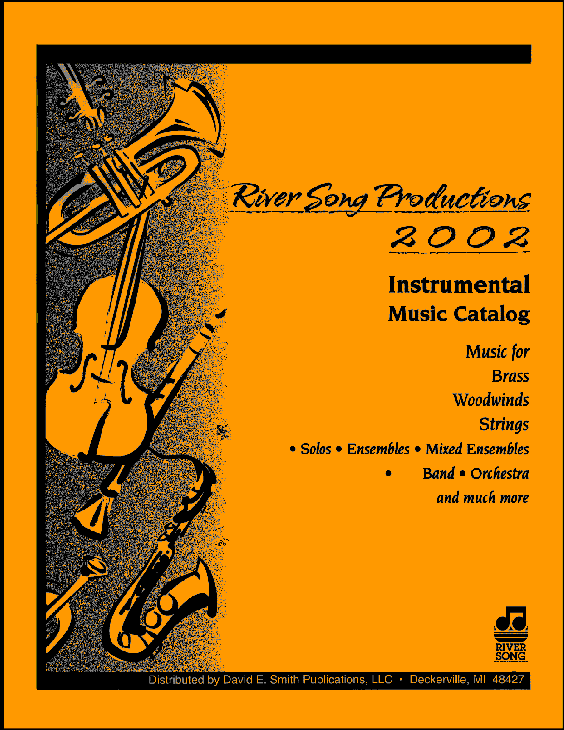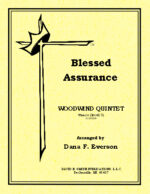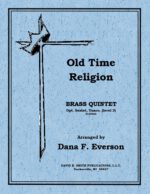| Instrument | |
|---|---|
| Level | 3 |
| Occasion | |
| Tune Name | |
| Theme | Coventry Carol |
| Hymn First Line | Coventry carol |
| Writer | |
| Composer | |
| Publisher | |
| Copyright | 1996 |
| Key | Eb, Ab |
| Meter | 3-4 |
| Idiom | Brass quintet |
| Form | Song (binary) |
Coventry Carol
$14.95
Related products
-
Only A Sinner
$10.00A woodwind quartet for Flute, oboe, and two clarinets with optional parts for flute and alto sax. Plus a set of fifth parts for bassoon or bass clarinet can allow for the piece being a quintet. The first statement is in the clarinets where it leads into a full ensemble passing the lines amongst the parts. A delightful little segue leads to a modulation where the tune is in the lower lines alternated with flourishes in the flutes. This Alternating texture carries on for some time. Then the tempo picks up for a vibrant exclamation where the theme is once again bantered about where it makes one final boast and concludes.
-
Blessed Assurance
$9.00This woodwind quintet (with opt. parts) is constantly on the move. While the melodic material is always made aware, the accompanying parts are full of movement. Even with metrical changes there is a constant flow giving a sense confidence and resolve. It bubbles from beginning to end and finally makes a solid statement of assurance.
-
I Will Sing Of The Mercies
$9.00A woodwind quintet with opt. parts for Alto Sax and Bass Clar. This piece presents itself with a sense of joy throughout with the introduction itself in a motivic manner setting the tone The piece passes through several modulations where the upper voices carry the melodic material while the lower voices support the ensemble with strength. The writing of this arrangement is well crafted to take advantage of the “woodwind quintet sounds.” It continues that way right up to the very end with a declamatory statement of “Mercy.”
-
Old Time Religion
$12.00A traditional brass quintet with an optional baritone part which allows to be a sextet as well. The beginning is active establishing a happy beginning to the piece. Then all the parts are in straight harmonies and then become fragmented. A modulation takes place allowing the lower voices to carry the tune. Then a tuba sola solo commences with light upper parts decorating the lines, until the parts fragment. This concludes with a modulation with motivic statements. After a brief intermission the piece takes off again with the tune in the lower voices and the trumpets add a flurry descants. As the piece comes to a close more and more voices add to the mix until the pieces adds a solid, grand statement.
-
A New Name In Glory
$9.00A brass quintet with opt. Trumpet for horn and baritone TC. It begins with fanfare motifs of the tune and then breaks into the hymn adding more parts as it progresses. It continues with a Q&A type of dialog between the lower, then upper voices. The second setion in a different key is reminiscent of the opening only this time in the middle voices and again moves in a Q&A type of dialog. Again modulating to a new key the theme is bounced around with rhythmical interest only to finalize in strong chordal patterns and ending on a bold declamation.
-
-
Assurance March
$9.00A traditional brass quintet with opt. trumpet for horn and extra baritone for use as a sextet. A piece in Alle Breve, is simply stated in block chords with an active bass line. The first strain, is repeated, and follows traditional march scoring. The second section is a bit slower and again in block chord structure, but this time with a first trumpet obbligato. With a regaining of tempo and style the piece becomes stronger until a grandiose ending.
-
Hallelujah! We Shall Rise
$12.00A standard brass quintet with optional baritone for a sextet. The introduction starts in the tuba and then adds more voices as you would expect- rising! The tune is now bantered about between the upper voices and then lower ones. Modulation! And the Q&A game continues. Another modulation and the tempo suddenly changes to a slower, expressive one with the French horn featured. As before the Q&A continues. Another modulation and an “a tempo” where the piece now in full ensemble starts lower and softer and continually adds activity and pitch raising until a vigorous conclusion.









